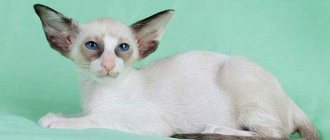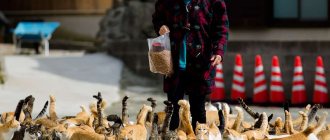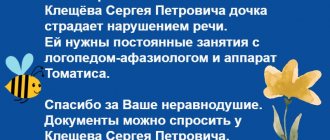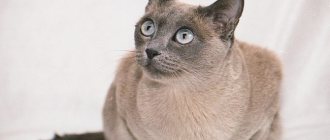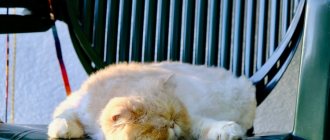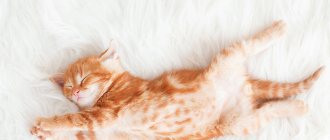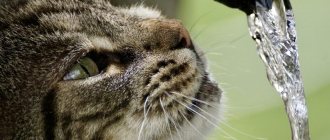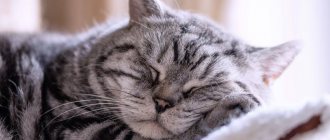Nature and features of the anomaly
Polydactyly, or polydactyly , is an anatomical anomaly that consists of the presence of extra fingers.
Polydactyly is transmitted genetically
It is customary to distinguish the following forms of manifestation of polydactyly:
- preaxial – another thumb (typical of multi-toed cats);
- postaxial – extra little finger (more common in people with polydactyly).
A polydactyl cat does not have problems with the musculoskeletal system; this does not prevent the kitten from leading a full life.
The extra finger is only noticeable visually - the kitten's paws resemble mittens - but this does not interfere with the normal development of the baby.
A little history
Cats with such an unusual paw structure have always been found. English settlers brought the first individuals to the United States and a small population of them currently lives in Boston.
Sailors, while sailing, always took a “cat in mittens” with them. It was believed that extra fingers helped animals to be stable on the deck and better catch mice. An increased number of polydactyl cats has always been observed in port cities. Traveling to all directions of the world on ships contributed to the spread of unusual animals throughout the world.
Benefits of Polydactyly
In North America, polydactyly is most common in Maine Coons and is considered a virtue of the breed.
Such cats have many advantages over ordinary cats:
- light, silent tread;
- improved swimming and snow walking skills;
- great tenacity;
- improved sense of balance.
All this helps cats hunt better.
Polydactyly in cats
Broadfoot generally does not require surgery. Pets with this anomaly live normal lives and have healthy offspring.
What does the term mean?
Polydactyly is a natural mutation characterized by the appearance of extra fingers. This gene appears infrequently, in 50% of cases, and only if there is a change in one of the parent individuals. The reverse process is called oligodactyly. In addition, polydactic pets are considered more intelligent and playful.
Today breeders consider polydactyly to be the breed standard. It comes in two types:
- preaxial – extra thumb;
- postaxial – extra little finger.
The first type is more widespread than the second. Often, only the forelimbs are affected by mutations. It is a proven fact that more than half of the Maine Coon population has mutations.
Experts divide polydacts into “correct” and “incorrect”. The “correct” ones include individuals with extra fingers that do not have any problems. Maine Coons are called “incorrect” if they have physical underdevelopment, which in turn leads to curvature of the forearm joints and bones. As a rule, such cats are neutered.
This is interesting: What name should I give to a ginger cat?
Differences between Maine Coon polydacts
A cat or polydact cat can belong to any of the breeds bred by humans.
The mutation is most common in Maine Coons: in 40% of the breed, the animal has an extra toe.
Such an anomaly as the third phalanx is dangerous
This feature was passed on to polydactyl Maine Coons by their ancient ancestors, who were forced to live and hunt in a snowy environment, when it was necessary to quickly and easily move through the thickness of the snow.
More recently, an extra toe on an animal meant the inability to participate in exhibitions and claims for awards, there was a ban on breeding, but today polydactylism is not considered a disadvantage: representatives of the MCBFA association have created a special standard specifically for wide-footed Maine Coons.
Such individuals participate in the championship, which is organized by the New Zealand Cat Fancy.
Multi-toed cats are recognized by TICA and WFA, while others are gradually coming to a similar understanding.
Description
Most often, the Maine Coon Polydact looks much larger than its ordinary relatives. The paw of such a cat is wider and differs from the standard shape. Their limbs resemble mittens due to their fingers protruding to the side. Sometimes you can also hear “snowshoes,” which also means paws with changes.
Individuals with the mutation also have a noticeably wider chest. It is more difficult for a polydactyl kitten to adapt, and accordingly, he begins to walk a little later than ordinary cats. The joints and ligaments of six-toed cats are usually stronger, which means that the individuals are healthier both physically and mentally. The coat color is no different from normal.
Kittens are very playful and often play with themselves. This breed does not like to sit still; if they do not have the opportunity to expend energy, showing their abilities, they can become depressed. Representatives of the breed will never bother you, they really like small children and will never offend them. The main feature is loyalty; it is not for nothing that they are often compared to dogs. The owners note that their intelligence is similar to that of a human, they are very talkative and know how to love.
Status of polydactyl individuals
Polydacts began to be recognized only in 2008. Although they are considered a deviation from the standards, they can still participate in exhibitions, but cannot take place. Nowadays, separate standards are being developed for individuals with the mutation, and it would not be surprising if in the near future they will be able to compete for the championship title. There are various organizations that recognize and support cats with mutational changes. For example: CFA, TICA, CFF and ACFA.
The majority of Maine Coons with polydactyly are found in the United States. There are few of them in our country. Many consider them attractive animals that bring good luck to the home. Another part, a relatively small one, thinks that they are ugly. In ancient times in Europe, such cats were exterminated; all deviations from the norm were not recognized.
Breeding
Over time, attitudes towards polydactyls have changed. If before the 80s such a phenomenon amazed no one and did not attract public attention, then in the 90s everything changed. The creation of special nurseries for breeding cats with the mutation began. Nowadays, polydactyl Maine Coons are very popular, participate in exhibitions and are in no way prohibited in countries around the world. The idea of separating special individuals into a separate species is being put forward.
To get a cat with a mutation, one of the parents must be its carrier. Considering that the gene is dominant, the chance of having a polydactyl kitten is 50%. Through a generation, the mutation is not transmitted in the same way as the shape of the paws. It may differ from the parent, having a different shape and number of fingers.
Other subspecies
Maine Coons appeared in Europe only in the 70s, and since then constant breeding work has been carried out. It was thanks to hard work that new colors and some interesting features appeared. An elongated muzzle, slanted eyes, a long body and thick fur are all characteristic features of the European Maine Coon.
American representatives are smaller in size, but no less developed muscles and endurance. They look quite friendly due to their round, expressive eyes. The presence of thick, luxurious wool with tabby patterns gives them a certain charm. There are no tufts on the wide-set ears.
Breeding wide-footed cats
Broad-footed Maine Coon breeds are bred in nurseries based on breeding programs, where the corresponding gene is passed on between generations. To produce offspring with polydactyly, one parent must have a foot anomaly - then the birth of offspring with polydactyly is possible with a probability of 56% (not all kittens in the litter are polydactylic).
If you breed two wide-legged animals, the likelihood of having polydact kittens increases by another 20%. Mating, where one parent is a homozygous polydact, leads to the fact that the entire litter will be polydactyl.
Polydactyly in cats
The polydactyly gene behaves unpredictably. It is expressed differently in offspring, regardless of the combination of fingers of the parents. In contrast to other dominant genes, it manifests itself in different ways in both homo- and heterozygous forms.
Breeders of broad-toed cats continue to conduct statistical work, trying to discover more accurate information about the likelihood of producing multi-toed kitten offspring.
Be sure to read:
What to feed a Maine Coon correctly: an adult cat, a kitten or a female cat
How to care for cat paws
All cats instinctively take great care of their paws, and the owners’ task is to help them do this as much as possible. Even a very minor injury - a scuff, crack or scratch on the pads of the fingers can greatly unsettle your pet: he will become irritable or, conversely, depressed, and lose his appetite. In addition, wounds in this area are extremely painful, and sensitive cats suffer greatly from them.
The causes of injury to the pads of the paws and fingers can be very different:
- physical - cuts from sharp objects at home or while walking;
- thermal - cats often get burns by jumping, for example, on a hot stove, and in extreme cold, frostbite occurs on their fingers;
- chemical - if an animal walks in the snow in winter, then the substances that are sprinkled on it may cause a chemical burn on the foot;
- improper nutrition - unbalanced, poor-quality feeding leads to cracking of the skin on the pads and the appearance of weeping ulcers.
Even a minor finger injury can have serious consequences.
Some skin and internal diseases or severe stress can also negatively affect the condition of cat fingers. Such problems require diagnosis and comprehensive treatment under the supervision of a veterinarian.
To eliminate the problem, you need to identify its cause in a timely manner, and for this you should periodically carefully examine your pet’s paws. And at the slightest violation of the skin on the pads and fingers, immediately wash and heal the wounds. It is also very important to constantly monitor the condition of the claws - make sure that they do not grow too long, do not split or get injured.
Trim your cat's claws promptly
An excessively overgrown claw or neglected injuries are common causes of inflammatory processes, which in some cases can even lead to amputation of a finger.
If your cat does not wear down her claws naturally, she will need to have her nails done by herself or by a veterinarian as they grow back. To prevent your pet from damaging upholstered furniture and wallpaper with its claws, just buy him a good scratching post or make one yourself from scrap materials - it’s not difficult at all.
Buy your cat a good scratching post
In polydactic cats, the claws on the “extra” toes grow at a faster rate than on regular toes. This must be taken into account in order to adjust their length in a timely manner.
Video: DIY scratching post - it's easy
Where to buy kittens, how much do they cost, how to distinguish a fake?
You should buy a Maine Coon kitten from a nursery whose owner has a license. Often buyers pre-order a kitten - black, red or blue, which they can expect for a year or more. Each animal must have a certificate and a veterinary passport, which contains information about vaccinations.
You can make sure that this is a Maine Coon only by consulting a specialist. It is worth buying a cat that is at least 3–3.5 months old. At this age, it is already possible to distinguish a real Maine Coon from a mestizo, since external characteristic features are already appearing - a pattern on the face (tabby), tassels on the ears, tufts of hair between the fingers.
The cost of a kitten depends on many factors: color, weight, presence of defects, age. For a three-month-old baby they can ask for from 600 to 1000 dollars, an adult cat costs more. A cat intended for breeding will cost even more. Maine Coons that are not suitable for participation in exhibitions (mixed breeds, polydacts) are cheaper. At the same time, a polydact can produce a healthy litter, since their feature is not inherited.
Share with friends!

